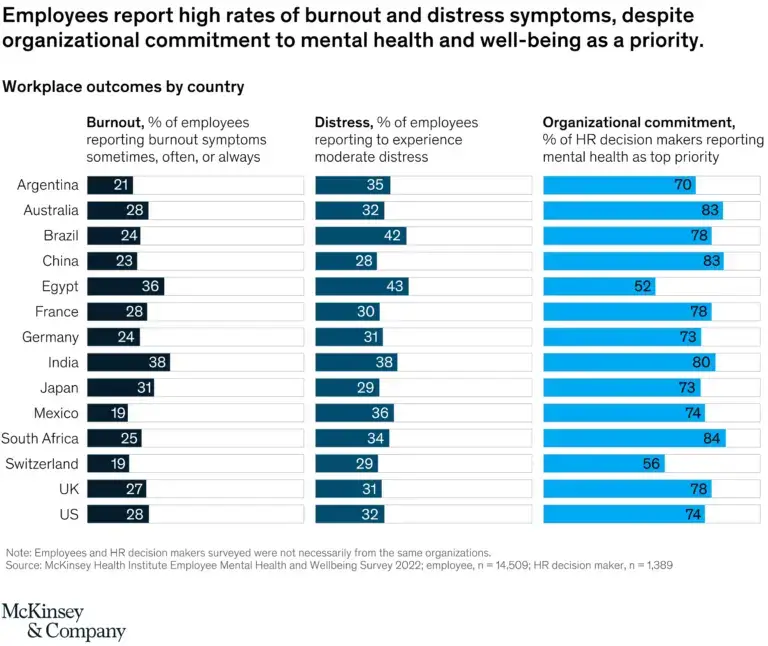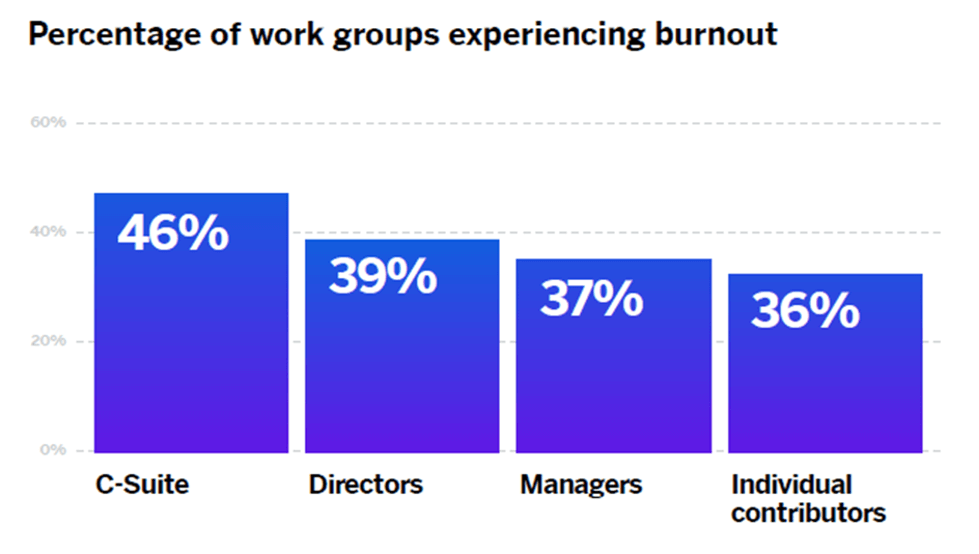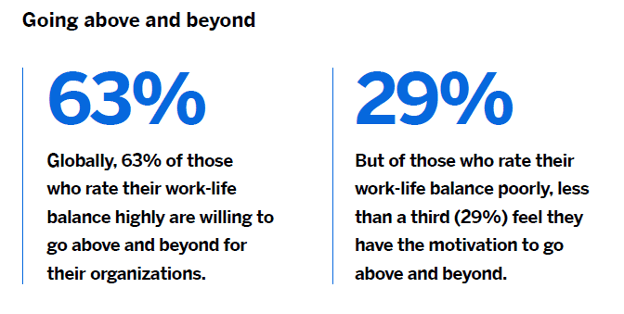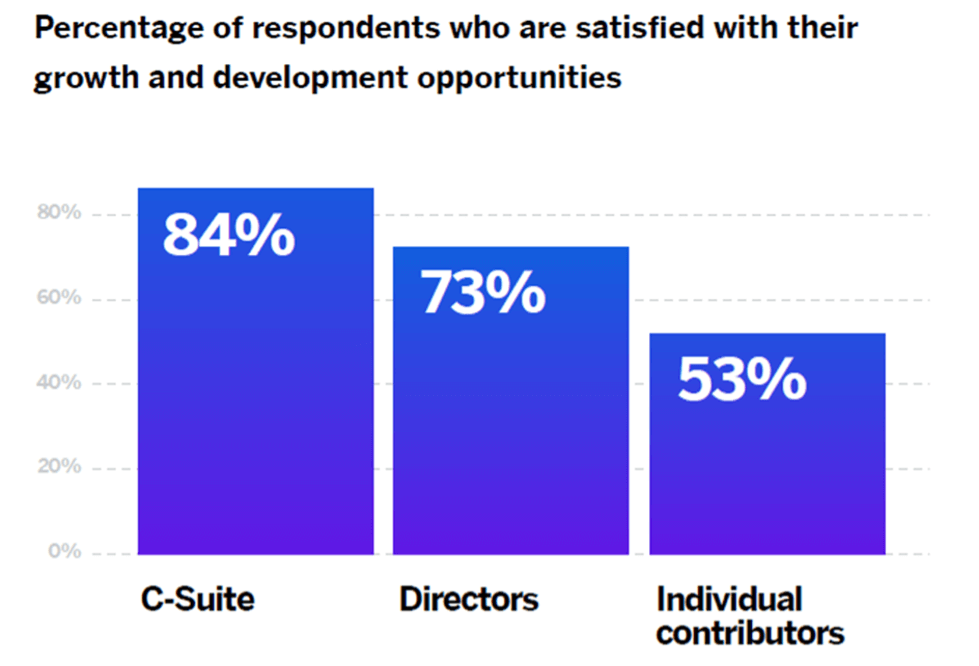What is employee burnout?
Employee burnout is an unpleasant mixture of work stress, exhaustion, and negative, cynical feelings. It’s closely connected to our job and our workplace, and the World Health Organisation recognises and defines this ‘occupational phenomenon’ as follows:
Burn-out is a syndrome conceptualised as resulting from chronic workplace stress that has not been successfully managed. It is characterised by three dimensions:
- feelings of energy depletion or exhaustion;
- increased mental distance from one’s job, or feelings of negativism or cynicism related to one’s job; and
- reduced professional efficacy.
A study by McKinsey of nearly 15,000 workers across 15 countries found that, on average, a quarter of employees report experiencing symptoms of burnout – despite HR professionals making employee mental health a top priority:

Image from Mckinsey
Our own 2023 Employee Experience Trends Report found that more than a third (38%) of employees feel they’re burnt out. We also discovered that the top driver of burnout this year is ineffective processes and systems. More on this later.
Employee burnout used to be viewed as a workers’ problem: if you were going to make a success of your career in the rat race, you had to manage your own mental health, self-care, and work-life balance to cope with whatever the job and your managers decided to throw at you.
Increasingly, though, employee burnout is considered a problem with the company, not the workers, and it’s up to everybody in an organization – leaders, managers, and employees themselves to speak up and address the issue.
Start listening to your employees with our free survey software
What are the signs of employee burnout?
Leaders and managers, and employees themselves need to look out for these signs of employee burnout in their teams:
- Increase in absenteeism
- Decrease in productivity
- Making more mistakes
- Difficulty remembering things
- Unmotivated and unenthusiastic about the job
- Poor decision-making
- Irritability and overly sensitive to feedback
- Cynical and negative attitude
- Exhaustion due to difficulty sleeping
- Lack of interest in workplace culture
If you notice any of these signs in yourself or your colleagues, it’s important to seek help and support. Burnout can have wide-ranging negative consequences for employees’ health, well-being, career – and the organization itself.
What causes employee burnout?
Bad processes and inefficient systems
While the pandemic relied on digital transformation and new technologies to support new ways of working, it also surfaced glaring inadequacies in many existing legacy processes and presented new challenges. Many employees had tolerated these system and process inefficiencies for years, and as a result, almost 4 in 10 feel burnt out and less productive than they’ve ever been.
Unmanageable workload
Chronic overloading, with perhaps being urged to work faster, results in: not being able to get work done effectively, and having little time for leisure and relaxation, or even career growth and development, which is unsustainable for any length of time.
Lack of control or autonomy
Feeling out of control of your work: timescales, schedules, workload, projects, resources and even decisions that affect your career and professional life, can all contribute to burnout. Without full job ownership, employees struggle to schedule, time-manage and deliver satisfactory work outcomes.
Micromanagement
Bound up with employees’ lack of control, micromanagement is a manager behavior characterized by excessive supervision, controlling employees’ work and how they do it, and a reluctance to delegate or allow their team to make their own decisions.
A toxic workplace culture
A culture that does not stamp out bullying, gossip, oppressive behavior (sexism, racism, homophobia, etc.), office politics, and general unfair treatment leads to people feeling psychologically unsafe. Psychological safety is essential for employees to be able to thrive in an organization and do their best work.
Unclear job expectations and lack of support
Unsupportive line managers, leaders, and co-workers lead to confusion, uncertainty, frustration and apathy.
Lack of work-life balance
Long hours and weekend working, always-on email and messaging encroach into personal life. No respite from work leads to burnout.
Being forced to come back into the office
Many people found working from home during and post-pandemic gave them greater work life balance and more time for family and leisure. Being forced back on a commute, working in an office environment and having to juggle caregiving responsibilities once more is enough to burn out some employees.
Reward
When employees feel the work they put in, maybe ‘going above and beyond’ for the organization doesn’t match the recognition and rewards given, this lack of appreciation may lead to burnout.
Too many meetings
While collaborative working can be great for innovation and creativity, too many meetings, reports, brainstorming sessions, and presentations can overwhelm workers who just want to quietly get on with their current task at hand in their own sweet time.
Poor time management
Setting unrealistic deadlines; over- or under-estimating the time needed to do tasks and failing to appreciate the pace at which each employee works can put time stress onto your teams.
Overloading the ‘stars’
The saying, ‘If you want to get the job done, ask a busy person’ means that the most capable employees are given the most work. It’s a mistake to overestimate the amount of work you think your team members can handle, and just because talented employees can work three times as fast as their co-workers, this doesn’t mean you can give them three times as many tasks.
The effects of employee burnout
Nobody benefits from overworking and burning out employees.
- For the employees themselves: At the very least, burnout leaves employees disengaged, disinterested, and performing poorly. More seriously, overwork and burnout can exact a terrible toll on people’s physical and mental health. Emotional exhaustion, anxiety, depression, addiction, sleep problems, gastrointestinal conditions, headaches, workplace accidents, and even serious health conditions such as cardiovascular disease and Type 2 diabetes can be linked to chronic stress at work.
- For the business: Every aspect of employee burnout – absenteeism, poor performance, decreased productivity, health issues, higher healthcare costs, accidents, talent attrition, and re-recruitment affects the bottom line, and can even go further into brand reputational damage and legal claims.
Why does preventing burnout matter?
Job burnout is damaging, for employers, for managers and for businesses. In the US, employee stress leading to workplace burnout costs corporations an estimated $125 billion to $190 billion a year.
Employees may feel, at the very least, disengaged, disinterested, with low job satisfaction leading to poor performance. More seriously, overwork and employee burnout can take a terrible toll on people’s physical and mental health, causing chronic health conditions and physical exhaustion.
Employers who don’t even try to reduce employee burnout soon discover that their business results and bottom line are eroded by absenteeism, poor performance, lower employee engagement, decreased productivity, higher healthcare costs, accidents, talent attrition, re-recruitment costs and even legal claims and brand reputational damage.
It’s not just employees who are feeling burnt out. Globally, leaders are feeling the strain, too. Almost half of C-suite executives reported burnout symptoms:

12 ways to prevent workplace burnout
1. Employees need a clear work purpose and expectations
Nobody works effectively when they have little guidance on what they are doing and why. Nowadays, being employed isn’t just about having a job — it’s a core part of a person’s value system.
Since the pandemic, many people have discovered a deeper appreciation for life, and want to belong to organizations that reflect, champion, and live their values: whether that’s taking a stance on climate change or offering employees what they need to grow and develop their careers.
Our Employee Experience Trends 2023 Report found that the desire for alignment of values is one of the top 5 drivers of Inclusion and Burnout.
To give employees a clear work purpose and expectations:
- Push forward with a purpose that unites and inspires people
- Make organizational values and their foundations visible
- Beware of ‘job creep’ as employees take on more responsibilities to help keep businesses and communities afloat. Determine what’s reasonable for the level and pay grade your employees are on.
- Focus on values and assess how work processes currently align with them
- Ensure everyone is up-to-date on your organization’s progress and know what’s required for success
2. Respect employee boundaries
Employees have been operating at surge levels for years, even before the pandemic. Going above and beyond has become employers’ expectation rather than the exception. Now, employees are reclaiming healthy boundaries by pushing back and reshaping the relationship they have with work.
According to our Employee Experience Trends 2023 Report When employers respect boundaries so that workers get better work life balance, almost two-thirds (63%) of employees are willing to go above and beyond for their organization.

To respect employee boundaries:
- Check in on employee well being and make sure people are not overwhelmed with a heavy workload
- Treat employees with respect, and be open and transparent
- Offer more ways for employees to balance work and life to reduce stress on their family
- Improve efficiency around workloads
- Offer work flexibility and the option for employees to choose their working hours
3. Ensure efficient processes and systems
Our Employee Experience Trends 2023 Report found that more than a third (38%) of employees feel they’re burnt out, and the top driver of workplace burnout this year is ineffective processes and systems.
While the pandemic sped up digital transformation and adoption of new technologies to support new ways of working, it also uncovered the glaring inadequacies of many existing legacy processes.
At the same time, expectations and workloads increased. Employees are often expected to do more with less and are not being equipped with the right tools and processes to consistently achieve the levels of productivity that organizations now demand of them to do their job effectively.

To ensure efficient processes and systems:
- Innovate and upgrade work processes and systems to get ahead of the need rather than fall behind
- Make employees’ jobs easier by removing obstacles and shonky legacy systems
- Encourage employees to flag up pain points where processes and systems frustrate them
- Don’t make processes harder than they need to be, and show your people that you care about how they work.
4. Paid Time Off (PTO)
Vacations are there for a reason: to rest, relax and recharge your employees, to combat burnout. The fad for not taking all one’s PTO is one of the causes of employee burnout.
Worryingly, one survey found that 42% of workers had not taken time off in the last 12 months. Some of the reasons given were:
- The expense of taking a vacation (47%)
- Self-imposed pressure to stay on top of work (31%)
- A heavy workload (27%)
- No paid time off (25%)
- No co workers available to cover their workload (25%)
Clearly, this is indicative of an unenlightened and unsustainable company culture that’s a recipe for employee burnout.
To ensure your people take all their PTO:
- Encourage employees to take their vacation time
- A supportive manager should practice what they preach by taking all their PTO, modeling behaviors that reduce burnout
- Even consider offering Unlimited PTO: employees don’t receive a set number of paid days off for the year – instead, they’re given the freedom to take time off when they want to, as long as it doesn’t adversely affect business objectives
5. Flexible working practices
Letting your people work flexibly will relieve stress and lower employee burnout while increasing job satisfaction. When you offer flexible scheduling and work hours, and work from home options, you support employees to spend more of their personal lives with their family and enjoy a home life/workplace balance.
To ensure flexible working practices:
- Initiate flexible working hours: Employees choose their own schedule, breaks, and shifts, and if they want to compress their days into a four day workweek, they can.
- Consider job sharing: Two or more employees share one role so that each can work part-time, but the full-time role is covered.
- Set up remote working: Allowing employees to work from anywhere (WFA): home, the office, abroad, is the hallmark of flexible employers. In a changing environment, a combination of remote working and onsite working, known as hybrid working, is likely to become the norm.
- Relax the dress code: An organizational culture that has a flexible approach to work attire – casual clothes such as jeans, T-shirts and sweaters, instead of formal business suits means that employees can feel more comfortable wearing what they want, and also express their personality through their clothes.
6. Mental health days
Workplace burnout results from the stress of an overwhelming workload, inflexibility, lack of direction and clarity, micromanagement, high role expectations, interpersonal stressors, and unfair treatment. These all affect employees’ mental health and can lead to breakdowns and staff turnover.
We’ve all heard of ‘duvet days’ – sanctioned days off whenever employees aren’t ill, but are too exhausted to work productively and are better off resting. Many employees still don’t consider mental health as a legitimate reason to miss a day of work, but time off in stressful times is essential to prevent employee burnout.
To ensure employees take advantage of mental health days:
- Make them available to everyone
- Empower managers to sanction mental health days
- Communicate to your team that it’s OK to take a mental health day
- Ask employees if mental health days are helping
7. Recovery time
When employees are recovering from workplace burnout, they must be supported by both their manager and the organization, and not flung back into a stressful work schedule.
To ensure employees get recovery time:
- Make sure they feel supported and recognized for their work
- Give them clear, meaningful goals that are within their power to achieve
- Make sure their work environment is pleasant and comfortable
8. Social interaction
It’s essential that people have supportive relationships and love in their lives, even at work. Encouraging people to interact with each other rather than working in closed-off silos contributes to preventing workplace burnout.
To ensure social interaction:
- Create a culture of belonging, where everyone feels included and safe
- Have a diverse and inclusive workforce
- Organize socials, trips out, and team bonding days so each team member gets to know each other
9. Encourage well being
In addition to promoting good mental health, encourage physical well being at work too – the two are interconnected. And there’s a link between employee engagement and well being. Research shows that employee engagement and well being are reciprocal, each influencing the other.
Encourage well being by sanctioning:
- Healthcare plans
- Gym subscriptions
- Work sports clubs
- Exercise classes for mind and body
- Breaks to get out into fresh air
10. Train managers
Research shows that no one has a more powerful influence on burnout in the workplace than a direct manager. They may cause burnout, or they may reduce burnout.
Managers must be trained to:
- Take responsibility for addressing burnout and preventing it
- Listen to direct reports: what’s working and what isn’t, and take action
- Set clear goals, expectations, schedules, and balanced workloads, and prepare to be flexible
- Encourage collaboration, but don’t force it
- Support employees to do their best work, maybe automating tedious tasks
- Model behavior: don’t work through lunch or on vacation, or not take PTO, as this encourages employees to follow suit
- Recognize early signs of job burnout and act by asking how employees are, their highs and lows, and how they can help make work easier
11. Employee career development
Growth and development opportunities are a core value, and one of the top drivers of intent to stay, inclusion, well being, and experience expectations. Organizations need to think of growth and development as an integral part of employee values.

To develop employees:
- It’s more than just providing access to training, development, and learning opportunities; employees must be given the time and support they need to benefit from it
- Develop career paths for people to progress into roles required for the future
- Provide opportunities for new starters to develop their skills
12. Listen to employee feedback – and act!
Our Employee Experience Trends 2023 Report found that there is a clear gap in the employee experience at present: although organizations are regularly asking for employee feedback, only 45% of employees strongly agreed/agreed with the statement: “I was given an opportunity to discuss the results from last year’s survey.” Sentiments like this are contributing to burnout rates.
It’s essential to:
- Act on the results of engagement surveys to show how you support employee well being
- Listen to the warning signs from team members who say they are burning out after going above and beyond consistently
- Have realistic expectations about employee metric ratings to help reduce burnout and stress
When you use an experience management platform such as Qualtrics EX25, you’ll be able to tell from survey responses and 360 feedback how your employees feel, and pick up the first stages of burnout in the workplace, ready to take action immediately.
And when you combine your operational (O) data and experience (X) data, you’ll also be able to pick up signs of burnout with metrics such as:
Combining O and X data gives you a more holistic view of your organization so you can step in and remedy problems preventing burnout in the workplace.
Free eBook: 2025 Employee Experience Trends Report